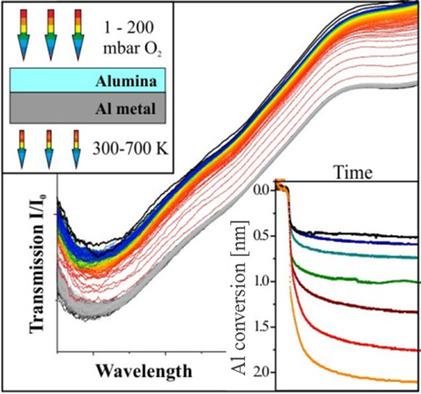当前位置:
X-MOL 学术
›
Phys. Status Solidi B
›
论文详情
Our official English website, www.x-mol.net, welcomes your
feedback! (Note: you will need to create a separate account there.)
Growth of Self‐Passivating Oxide Layers on Aluminum—Pressure and Temperature Dependence
Physica Status Solidi (B) - Basic Solid State Physics ( IF 1.5 ) Pub Date : 2021-01-16 , DOI: 10.1002/pssb.202000559 Jürgen Gorobez 1 , Björn Maack 1 , Niklas Nilius 1
Physica Status Solidi (B) - Basic Solid State Physics ( IF 1.5 ) Pub Date : 2021-01-16 , DOI: 10.1002/pssb.202000559 Jürgen Gorobez 1 , Björn Maack 1 , Niklas Nilius 1
Affiliation

|
Optical transmission spectroscopy is used to monitor the in situ oxidation of granular aluminum films over a wide range of temperatures and pressures. By fitting the time evolution of the transmission to adequate geometric models, the rising transparency of the sample is converted into oxide growth during reaction. The observed oxidation rates increase steeply with temperature, but depend on pressure only below 100 mbar O2 and become pressure‐independent above. The Al oxidation proceeds in two regimes. The initial fast one is compatible with the Cabrera–Mott mechanism of an electric‐field‐driven process and self‐terminates at 1–2 nm oxide thickness depending on oxidation conditions. The subsequent slow regime exhibits a two times larger activation energy and is relevant only for high‐temperature oxidation. It is assigned to the thermally activated transport of Al ions through the emerging oxide layer. In contrast to the initial Cabrera–Mott process, it shows no self‐passivation and enables oxide thickening beyond 2 nm.
中文翻译:

铝上自钝化氧化物层的生长-压力和温度依赖性
光学透射光谱法用于监测大范围温度和压力下颗粒状铝膜的原位氧化。通过将传输的时间演变拟合到适当的几何模型,样品的不断提高的透明度在反应过程中转化为氧化物的生长。观察到的氧化速率随温度急剧增加,但仅取决于低于100 mbar O 2的压力并变得与压力无关。Al的氧化以两种方式进行。最初的快速氧化膜与电场驱动过程的Cabrera-Mott机理兼容,并根据氧化条件在1-2 nm氧化膜厚度处自行终止。随后的慢态表现出两倍大的活化能,并且仅与高温氧化有关。它被归因于Al离子通过新出现的氧化物层的热活化传输。与最初的Cabrera–Mott工艺相反,它没有自钝化,并且可使氧化物增厚超过2 nm。
更新日期:2021-01-16
中文翻译:

铝上自钝化氧化物层的生长-压力和温度依赖性
光学透射光谱法用于监测大范围温度和压力下颗粒状铝膜的原位氧化。通过将传输的时间演变拟合到适当的几何模型,样品的不断提高的透明度在反应过程中转化为氧化物的生长。观察到的氧化速率随温度急剧增加,但仅取决于低于100 mbar O 2的压力并变得与压力无关。Al的氧化以两种方式进行。最初的快速氧化膜与电场驱动过程的Cabrera-Mott机理兼容,并根据氧化条件在1-2 nm氧化膜厚度处自行终止。随后的慢态表现出两倍大的活化能,并且仅与高温氧化有关。它被归因于Al离子通过新出现的氧化物层的热活化传输。与最初的Cabrera–Mott工艺相反,它没有自钝化,并且可使氧化物增厚超过2 nm。







































 京公网安备 11010802027423号
京公网安备 11010802027423号